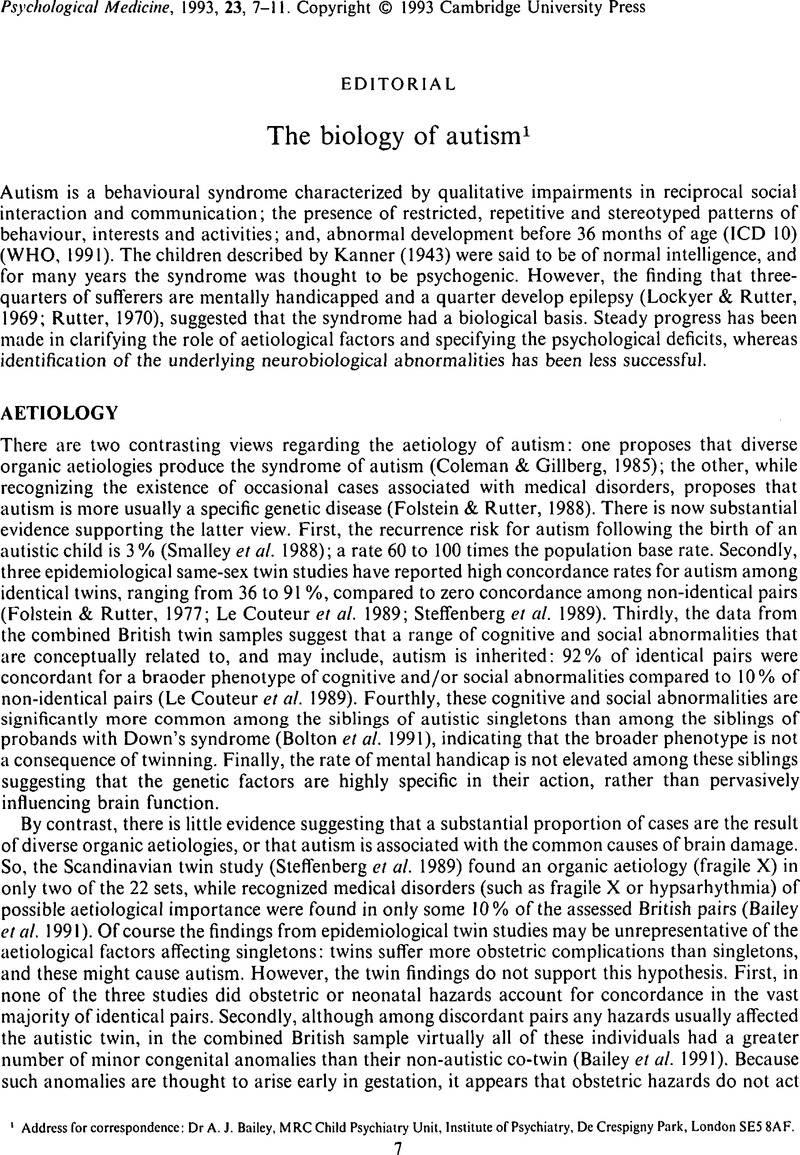Crossref Citations
This article has been cited by the following publications. This list is generated based on data provided by Crossref.
Bailey, Anthony
Luthert, Phillip
Bolton, Patrick
Le Couteur, Anne
Rutter, Michael
and
Harding, Brian
1993.
Autism and megalencephaly.
The Lancet,
Vol. 341,
Issue. 8854,
p.
1225.
Rutter, Michael
Bailey, Anthony
Bolton, Patrick
and
Le Couteur, Ann
1994.
Autism and Known Medical Conditions: Myth and Substance.
Journal of Child Psychology and Psychiatry,
Vol. 35,
Issue. 2,
p.
311.
Ellis, Hadyn D.
Ellis, Diane M.
Fraser, William
and
Deb, Shoumitro
1994.
A preliminary study of right hemisphere cognitive deficits and impaired social judgments among young people with Asperger syndrome.
European Child & Adolescent Psychiatry,
Vol. 3,
Issue. 4,
p.
255.
Hughes, Carol
1994.
From confusional entanglement to sense of self: Aetiology, thinking and process in work with an autistic boy.
Journal of Child Psychotherapy,
Vol. 20,
Issue. 1,
p.
43.
Oades, Robert D.
and
Eggers, Christian
1994.
Childhood autism: An appeal for an integrative and psychobiological approach.
European Child & Adolescent Psychiatry,
Vol. 3,
Issue. 3,
p.
159.
Starr, Elizabeth
1994.
Facilitated communication: A response by child protection.
Child Abuse & Neglect,
Vol. 18,
Issue. 6,
p.
515.
Bailey, Anthony
Phillips, Wendy
and
Rutter, Michael
1996.
Autism: Towards an Integration of Clinical, Genetic, Neuropsychological, and Neurobiological Perspectives.
Journal of Child Psychology and Psychiatry,
Vol. 37,
Issue. 1,
p.
89.
Trepagnier, Cheryl
1996.
A Possible Origin for the Social and Communicative Deficits of Autism.
Focus on Autism and Other Developmental Disabilities,
Vol. 11,
Issue. 3,
p.
170.
PIKE, ALISON
and
PLOMIN, ROBERT
1996.
Importance of Nonshared Environmental Factors for Childhood and Adolescent Psychopathology.
Journal of the American Academy of Child & Adolescent Psychiatry,
Vol. 35,
Issue. 5,
p.
560.
Cryan, Elizabeth
Byrne, Majella
O'Donovan, Ann
and
O'Callaghan, Eadbhard
1996.
Brief report: A case-control study of obstetric complications and later autistic disorder.
Journal of Autism and Developmental Disorders,
Vol. 26,
Issue. 4,
p.
453.
Ramberg, Chris
Ehlers, Stephan
Nydén, Agneta
Johansson, Maria
and
Gillberg, Christopher
1996.
Language and pragmatic functions in school‐age children on the autism spectrum.
International Journal of Language & Communication Disorders,
Vol. 31,
Issue. 4,
p.
387.
Ehlers, Stephan
Nydén, Agtieta
Gillberg, Christopher
Sandberg, Annika Dahlgren
Dahlgren, Sven‐Olof
Hjelmquist, Erland
and
Odén, Anders
1997.
Asperger Syndrome, Autism and Attention Disorders: A Comparative Study of the Cognitive Profiles of 120 Children.
Journal of Child Psychology and Psychiatry,
Vol. 38,
Issue. 2,
p.
207.
Hanninen, T.
Hallikainen, M.
Koivisto, K.
Partanen, K.
Laakso, M. P.
Riekkinen, P. J.
and
Soininen, H.
1997.
Decline of Frontal Lobe Functions in Subjects with Age-associated Memory Impairment.
Neurology,
Vol. 48,
Issue. 1,
p.
148.
Sabbagh, Mark A.
1999.
Communicative Intentions and Language: Evidence from Right-Hemisphere Damage and Autism.
Brain and Language,
Vol. 70,
Issue. 1,
p.
29.
Wahlberg, Tim
2001.
Autistic Spectrum Disorders: Educational and Clinical Interventions.
Vol. 14,
Issue. ,
p.
37.
Rinehart, Nicole J.
Bradshaw, John L.
Tonge, Bruce J.
Brereton, Avril V.
and
Bellgrove, Mark A.
2002.
A Neurobehavioral Examination of Individuals with High-Functioning Autism and Asperger’s Disorder Using a Fronto-Striatal Model of Dysfunction.
Behavioral and Cognitive Neuroscience Reviews,
Vol. 1,
Issue. 2,
p.
164.
Jarrold, Christopher
and
Happé, Francesca
2006.
Encyclopedia of Cognitive Science.
Badawi, Nadia
Dixon, Gleny S
Felix, Janine F
Keogh, John M
Petterson, Beverly
Stanley, Fiona J
and
Kurinczuk, Jennifer J
2006.
Autism following a history of newborn encephalopathy: more than a coincidence?.
Developmental Medicine & Child Neurology,
Vol. 48,
Issue. 2,
p.
85.
Freitag, C M
2007.
The genetics of autistic disorders and its clinical relevance: a review of the literature.
Molecular Psychiatry,
Vol. 12,
Issue. 1,
p.
2.
Lenoir, Pascal
Malvy, Joëlle
and
Bodier-Rethore, Chrystèle
2007.
L'autisme et les troubles du développement psychologique.
p.
109.



